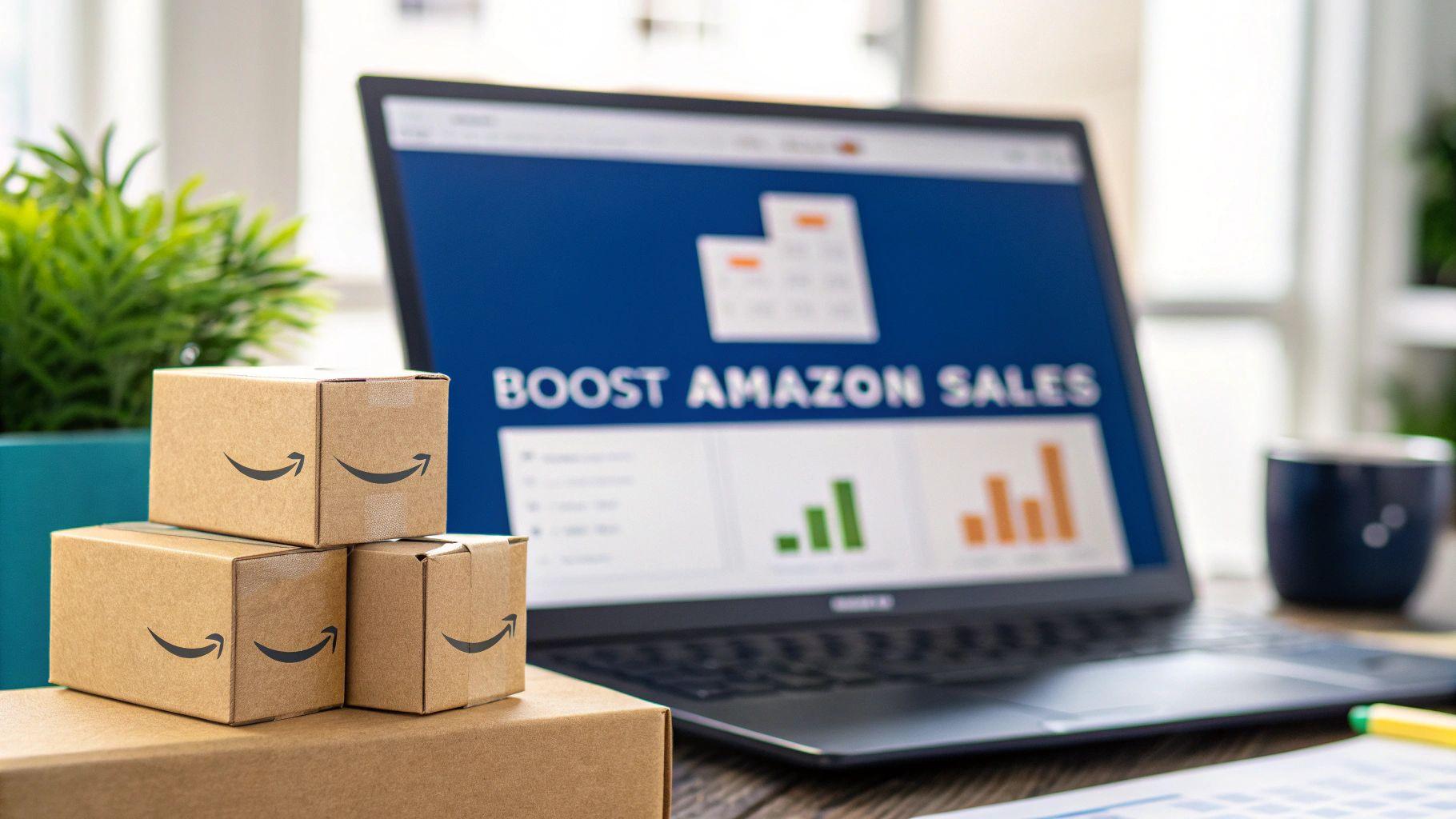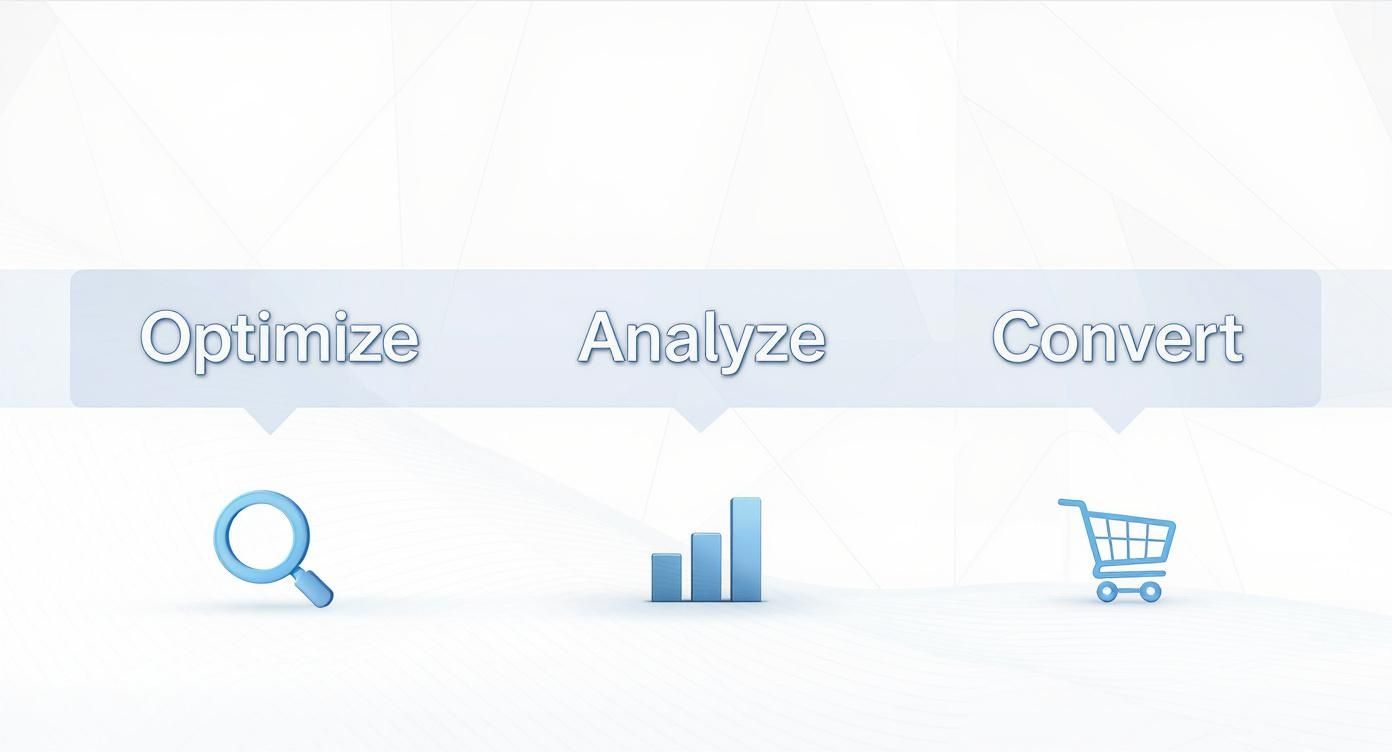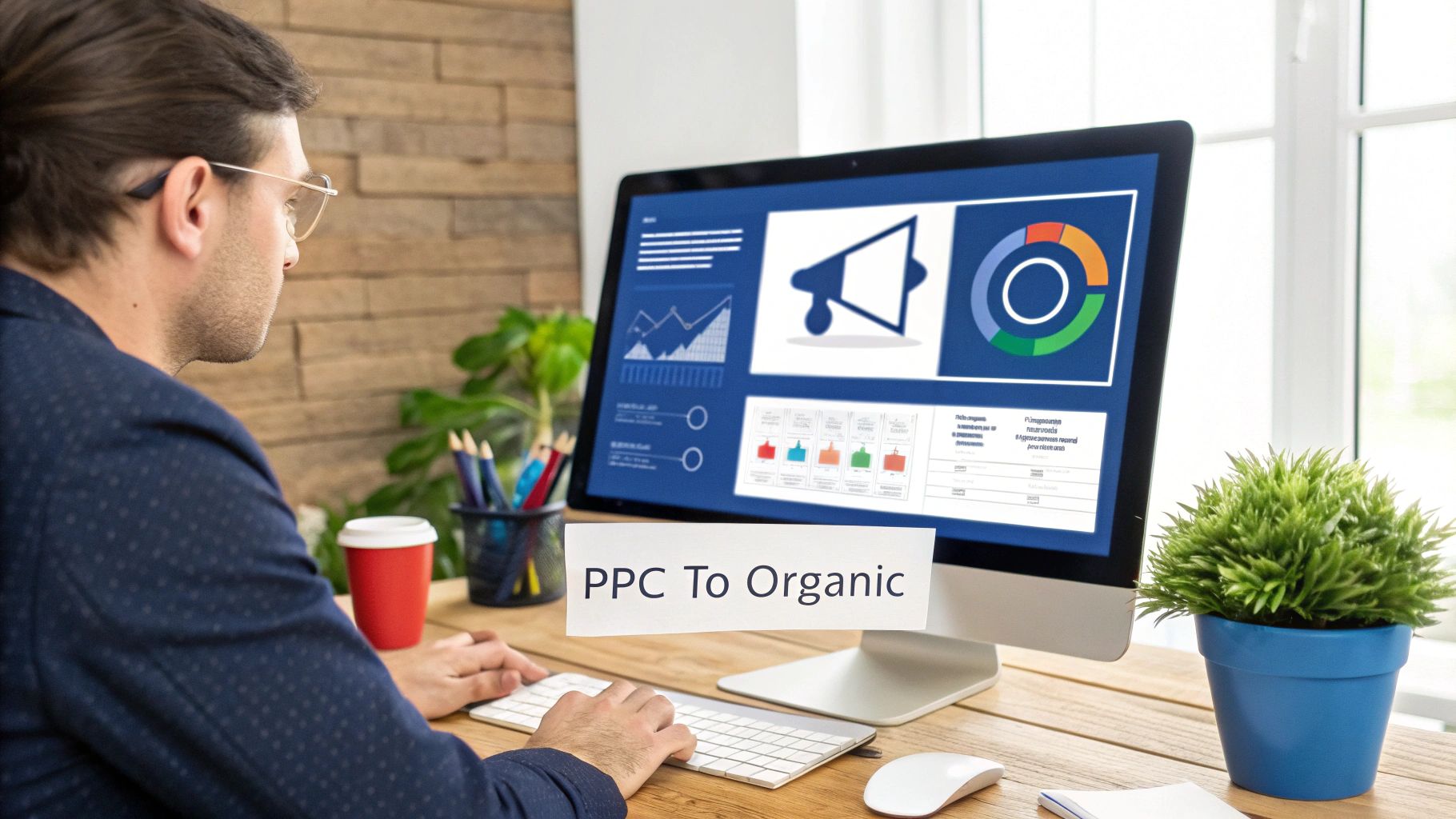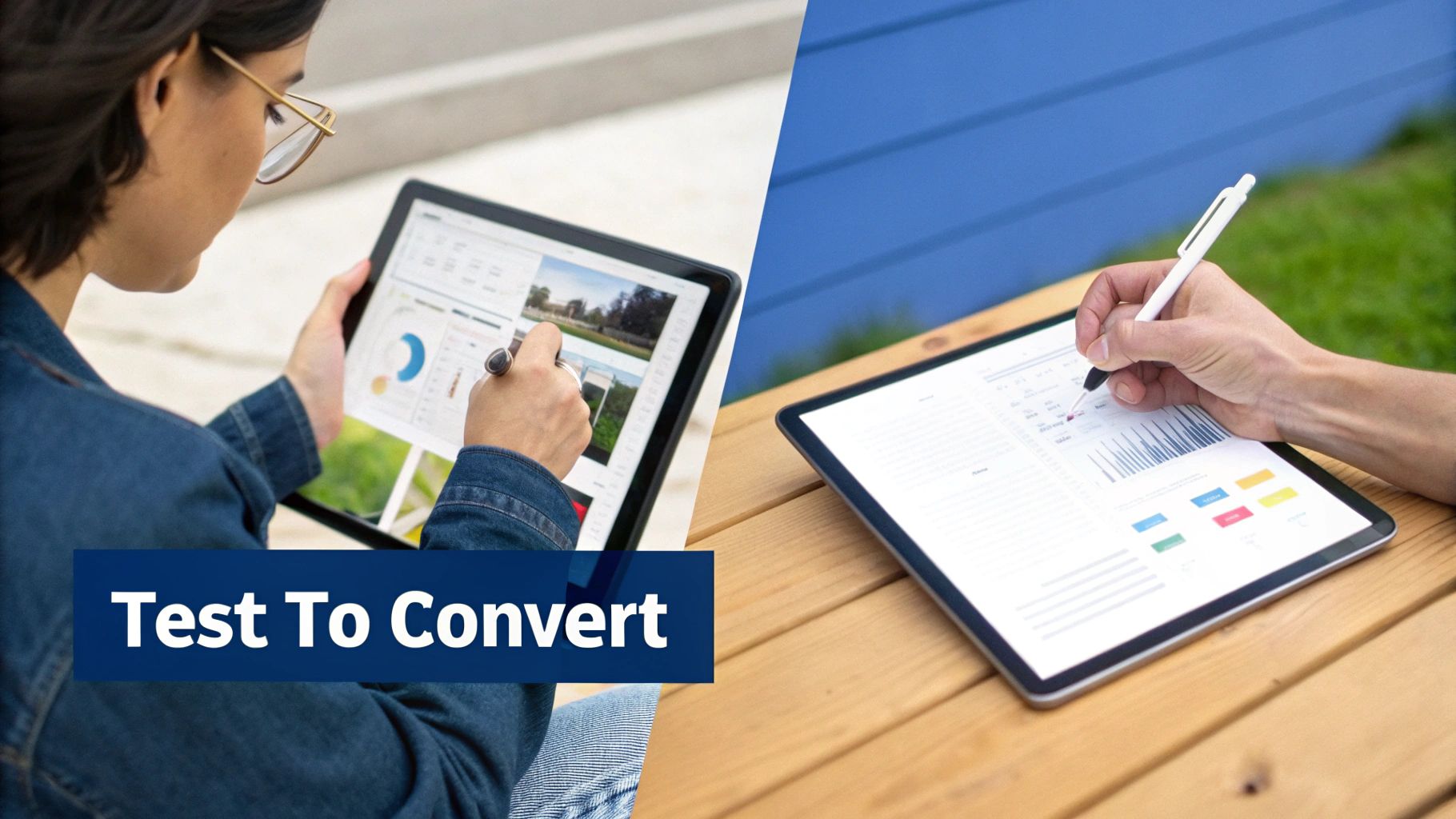How to Improve Amazon Sales: A Performance-First Guide for Brand Leaders
Learn how to improve Amazon sales with performance-first tactics. This guide covers PPC, listing optimization, and data-driven strategies for real growth.

Improving Amazon sales isn't about outspending the competition; it's about outsmarting them. For mid-to-senior eCommerce leaders, the goal is sustainable, profitable growth, not just a temporary spike in revenue. This requires a performance-first mindset where every decision is strategic and data-driven.
The foundation of this approach is retail readiness. Jumping straight into PPC without an optimized product listing is like pouring marketing dollars into a leaky bucket. Top-performing brands understand that a product detail page is their most valuable asset—a 24/7 salesperson. Before you drive a single click, that page must be engineered to convert. This isn't just about keywords; it's about building a compelling case for your product that turns browsers into buyers.

Start with a Performance-First Listing Audit
You can't optimize what you don't measure. A performance audit evaluates your listing from two critical perspectives: the customer's experience and the A9 algorithm's ranking factors. It's a candid assessment of your current conversion potential.
Scrutinize these key areas:
- Visual Merchandising: Since customers can't physically interact with your product, your images and videos must do the heavy lifting. A best-in-class asset stack includes high-res studio shots on a white background, lifestyle images demonstrating the product in use, infographics highlighting key benefits, and a short video. For example, brands that add video to their listings have seen conversion rate increases of up to 80%.
- Conversion-Focused Copy: Your title, bullet points, and description must be a seamless blend of high-intent keywords and persuasive, benefit-driven language. Answer the customer's primary question: "How does this solve my problem?"
- A+ Content: This is your brand's opportunity to dominate the lower half of the page. Use it to tell your brand story, address common objections with comparison charts, and dive deep into product features. Well-executed A+ Content has been shown to boost conversion rates by an average of 5-10%.
This audit checklist helps prioritize your optimization efforts on the elements that will drive the most significant performance improvements before you spend a single dollar on ads.
Your Retail Readiness Audit Checklist
| Audit Area | Key Metric | Actionable Goal | Impact Level |
|---|---|---|---|
| Title | CTR | Include top 3-5 keywords & key benefits | High |
| Main Image | CTR | Meets Amazon's standards; stands out | High |
| Images/Video | CVR | At least 7 high-quality assets | High |
| Bullet Points | CVR / Indexing | 5 benefit-driven points, keyword-rich | High |
| Reviews & Rating | CVR | 4.3+ stars, 25+ reviews | High |
| A+ Content | CVR | Live with brand story & comparison charts | Medium |
| Inventory | Sales Velocity | In stock (FBA or FBM) | Critical |
This audit provides a clear, prioritized action plan. Address the "High" and "Critical" impact items first to ensure your ad budget is invested in a listing primed for conversion.
Uncover Gaps with Competitive Analysis
Next, benchmark your listing against the top performers in your category. Analyze their strategy, but more importantly, identify their weaknesses.
A competitor's negative reviews are a strategic goldmine. They are an unfiltered source of customer pain points you can solve and explicitly address in your product features and listing copy. The Amazon marketplace is fiercely competitive. In 2023, independent sellers sold more than 4.1 billion products, underscoring the need to find every possible edge.
Let your analysis dictate your optimization. If your competitor's images lack context, make yours rich with lifestyle shots. If their A+ Content is a simple text block, build yours with engaging modules and a compelling brand narrative.
Headline’s POV: Your product listing is not a static asset; it’s a dynamic conversion engine. The goal is to make your page the most informative, trustworthy, and persuasive option for any given search. Before launching any campaign, verify your unit economics. A high-converting listing that loses money on each sale is a failed strategy. If needed, use this guide on how to calculate profit per unit to ensure you're building a profitable foundation.
Using PPC as a Lever for Organic Growth
Most brands view Amazon PPC as a direct cost to acquire sales. This is a limited perspective. The most sophisticated sellers understand that PPC is the most powerful tool for gathering data and the single best catalyst for driving sustainable organic growth.
The primary objective is not just to buy today's sales. It's to make a strategic investment in paid placements to ignite the Amazon flywheel effect. Every PPC-driven sale sends a powerful signal to the A9 algorithm, validating your product's relevance for a specific search term. This increase in sales velocity directly improves your organic ranking for those valuable keywords, creating a self-sustaining cycle where paid success fuels organic visibility.

Building a Full-Funnel PPC Structure
A single, broad campaign is an inefficient use of capital. A structured, full-funnel approach aligns ad types with business goals at each stage of the customer journey, maximizing ROI.
- Top of Funnel (Awareness): Introduce your brand to new audiences using Sponsored Brands and Sponsored Brands Video ads targeting broad, category-level keywords. The goal is to build brand recall before a customer begins a specific product search.
- Bottom of Funnel (Conversion): Target high-intent shoppers ready to purchase. Sponsored Products ads, appearing directly in search results and on product pages, are the workhorse here, designed to capture demand and close the sale.
This layered strategy ensures efficient ad spend by tailoring the message and ad type to the customer's position in the buying cycle.
Harvesting Keywords from Auto to Manual Campaigns
Your PPC campaigns are a real-time source of consumer search intelligence. A systematic process for capturing and acting on this data provides a significant competitive advantage.
Begin with a broad-match or automatic Sponsored Products campaign. This allows Amazon's algorithm to explore a wide range of relevant search terms. After gathering sufficient performance data (typically 2-4 weeks), begin the harvesting process:
- Identify Winners: In your search term report, isolate the exact customer search terms that are converting profitably.
- Migrate to Manual Campaigns: Move these proven keywords into a new, tightly controlled manual campaign where you can set precise bids and optimize for performance.
- Refine and Isolate: Add the winning search terms as negative exact match keywords in the original automatic campaign. This critical step prevents self-cannibalization and forces the auto campaign to continuously discover new, untapped keyword opportunities.
This systematic process transforms PPC from a guessing game into a predictable data engine. You are no longer hoping customers find you; you are using real performance data to ensure they do. It's a foundational concept, and if you're new to this, you can learn more about what Amazon PPC is and how these campaigns fit together in our detailed guide.
Focusing on Total Profitability, Not Just ACoS
While Advertising Cost of Sale (ACoS) is a useful metric for campaign-level efficiency, an obsession with minimizing it can stifle growth. Leadership should focus on a more holistic metric: Total Advertising Cost of Sale (TACoS).
TACoS measures your total ad spend against your total revenue (paid + organic).
A decreasing TACoS over time is the definitive indicator that your PPC investment is successfully driving the flywheel. It means your advertising is lifting organic rank and building brand equity, not just generating temporary sales. This shifts the strategic conversation from "How low can we get ACoS?" to "How can we strategically invest our ad budget to drive profitable, long-term growth?" This is the distinction that separates market leaders from the rest.
Driving Incremental Growth with Amazon DSP
While your PPC strategy captures existing demand, what about creating new demand? This is the role of the Amazon Demand-Side Platform (DSP). It allows brands to reach high-intent audiences with display, video, and audio ads—both on and off Amazon.
For brands that have mastered the fundamentals of search, DSP is the next strategic lever for proactive market expansion. It complements PPC by finding and influencing potential customers you would never reach through search alone.
Beyond Search: Retargeting and Conquesting
DSP's power lies in its sophisticated audience targeting capabilities. You are no longer just reacting to keywords; you are proactively engaging audiences based on their verified shopping behaviors, lifestyle attributes, and demographics.
Actionable DSP strategies include:
- Win Back Lost Customers: Retarget shoppers who viewed your product but did not purchase. For example, a campaign could serve a unique creative to users who viewed your product in the last 7 days, reminding them of key benefits to drive conversion.
- Competitor Conquesting: Serve your ads directly to audiences who have recently viewed or purchased from your top competitors. This offensive tactic can intercept their customers and drive consideration for your brand.
- Build Lookalike Audiences: Upload your first-party customer data (e.g., from your DTC site), and Amazon's algorithm will build a new audience of shoppers with similar behavioral patterns, effectively cloning your ideal customer profile on the Amazon platform.
This is a strategic shift from targeting what people type to targeting who people are. For a deeper dive, explore our complete Amazon DSP advertising guide.
Tapping Into Amazon's Massive Market Presence
Running DSP ads provides access to Amazon's immense first-party data. The scale is unparalleled. Amazon's US e-commerce sales are projected to reach $491.65 billion in 2024, securing a 40.4% share of the total US e-commerce market. DSP is your key to navigating this vast audience effectively. For more context, you can discover more insights about Amazon's market expansion on Oberlo.com.
This reach extends beyond Amazon.com. DSP leverages Amazon's data to place your ads on Amazon-owned properties like IMDb and Twitch, as well as across thousands of third-party websites and apps in its network, ensuring you reach your target audience wherever they are.
Headline’s POV: DSP is a strategic investment in creating new demand and generating incremental sales. Its success cannot be measured by last-click attribution alone. The focus should be on the "halo effect"—how display and video campaigns influence branded search volume, lift consideration, and increase overall sales velocity. This is how you build a durable brand within the world's largest retail ecosystem.
Use Data and Experiments to Turn Shoppers Into Buyers
Driving traffic is only half the battle. If that hard-won traffic doesn't convert, you are simply paying for clicks. A disciplined approach to Conversion Rate Optimization (CRO) is essential for maximizing the return on your marketing investment. This means moving beyond gut feelings and embracing a rigorous process of hypothesis-driven testing.

A/B Testing: Let Your Customers Tell You What They Want
Amazon's Manage Your Experiments tool is a powerful, free resource for data-driven optimization. It allows you to run head-to-head A/B tests on critical listing elements to determine what resonates most with real shoppers.
Systematically test different versions of your:
- Main Image: Does a lifestyle image outperform a studio shot? Does adding an infographic callout increase click-through rate? A small uplift here has a compounding effect on traffic.
- Product Title: Test a benefit-driven title ("Ultra-Soft Bamboo Sheets for a Cool, Restful Sleep") against a feature-focused one ("100% Organic Bamboo Sheet Set, Queen Size, 4-Piece").
- A+ Content: Test the impact of adding a competitor comparison chart or an embedded video on your conversion rate.
- Bullet Points: Experiment with leading with a key benefit versus technical specifications.
The process is simple: you create two versions of a single element, and Amazon splits traffic between them for a set period (typically 4-10 weeks), declaring a winner based on statistical significance. This eliminates guesswork and provides clear, actionable results.
Dig Into Amazon's Analytics for Deeper Insights
While A/B testing tells you what works, Amazon's analytics dashboards help you understand why. The Search Query Performance report is a goldmine, revealing the exact search terms customers use to find your products, along with impressions, clicks, and conversion data for each. A high-impression, low-CTR query indicates a mismatch between the search intent and your main image or title, signaling a clear opportunity for optimization.
Similarly, Brand Analytics provides crucial insights into customer behavior, such as frequently purchased product combinations and demographic data. Knowing your primary audience is millennials, for instance, might justify an investment to boost e-commerce sales with AI-generated UGC product videos, which often resonates more authentically with that demographic.
Use this roadmap to structure your testing program, starting with high-impact, low-effort experiments to build momentum.
Your Amazon CRO Experiment Roadmap
| Experiment Type | Hypothesis Example | Primary Metric (CTR/CVR) | Effort Level |
|---|---|---|---|
| Main Image | "Adding a key benefit icon to our main image will increase clicks." | CTR | Low |
| Product Title | "A benefit-led title will convert better than a feature-led title." | CVR | Low |
| Bullet Points | "Reordering bullets to lead with social proof will increase add-to-carts." | CVR | Medium |
| A+ Content | "Adding a lifestyle video to our A+ Content will improve time on page and conversions." | CVR | High |
Once a test produces a winner, that new version becomes the control for your next experiment. This creates a cycle of continuous improvement.
Headline’s POV: To win on Amazon, you must build a culture of experimentation. Treat your listing as a dynamic sales tool that requires constant refinement based on hard data. A simple main image test can often lift CTR by 10-15%, driving more traffic and sales without any additional ad spend. That is the definition of performance-driven marketing.
Promotions and Reputation: Your Conversion Power-Duo
On Amazon, strategic promotions and a stellar reputation are powerful conversion levers. This isn't about a race-to-the-bottom pricing strategy. It's about using promotions surgically to achieve specific business objectives, such as accelerating sales velocity for a new product or improving rank for a competitive keyword.
Promotions like Lightning Deals or Coupons are strategic investments in visibility. A successful deal can feature your product on Amazon's high-traffic deals page, creating a sales spike that the A9 algorithm rewards with improved organic ranking long after the promotion ends.
Using Promotions to Fuel Real Growth
Every promotion must have a clear strategic purpose. Are you liquidating inventory or pushing a new ASIN into the top 10 for its primary keyword? The tactic must align with the goal.
- Coupons for the Click: The orange coupon badge is a proven method for increasing both click-through and conversion rates. It makes your listing visually stand out in crowded search results, drawing the shopper's eye away from competitors.
- Lightning Deals for a Sales Surge: These high-visibility, short-duration events are ideal for generating a massive, concentrated burst in sales velocity. Use them to launch new products or to capitalize on peak traffic during events like Prime Day.
The goal is to signal value and create urgency, two powerful psychological triggers that drive purchase decisions.
Turning Your Reviews into a Moat
Your product's star rating is a critical factor in building instant trust. Reputation management requires a proactive plan for generating authentic feedback and, more importantly, learning from it.
Analyze your reviews—both positive and negative. They are a direct line to your customer's experience. Negative reviews are often a diagnostic tool, highlighting product flaws or misaligned expectations that need to be addressed in your next product iteration or listing update.
This customer obsession is core to Amazon's own success. The company's record-breaking revenue is fueled by operational excellence and a relentless focus on the customer experience. You can learn more about how Amazon is growing on DigitalCommerce360.com.
Headline’s POV: Treat your customer reviews as a free, continuous focus group. Use programs like Amazon Vine to secure crucial early reviews for new products, and regularly analyze review sentiment for recurring themes. This customer intelligence is invaluable for informing product development, marketing copy, and your overall brand strategy.
Answering Your Toughest Amazon Sales Questions
We've covered the performance-first playbook, from retail readiness to advanced advertising. Here are answers to the strategic questions we hear most often from brand leaders.
What’s a Realistic Growth Rate on Amazon?
This depends entirely on your category, competitive landscape, and starting position. A new brand in a saturated market faces different challenges than an established player launching a unique product.
Instead of chasing an arbitrary number, focus on sustainable, profitable growth.
- For established brands: A strong target is 10-20% YoY growth in total sales, achieved while maintaining or decreasing your Total Advertising Cost of Sale (TACoS). A declining TACoS is the clearest sign that your ad investment is successfully fueling organic growth.
- For new product launches: The initial 90 days are about velocity and visibility, not profitability. The high initial ad spend is an investment in data acquisition and ranking. Success is defined by achieving a top 20 organic rank for primary keywords and securing enough reviews (25+) to establish social proof.
How Should We Allocate Our Amazon Ad Budget?
Avoid the common mistake of simply funding the campaign with the lowest ACoS. A strategic budget allocation should follow your full-funnel strategy.
A balanced starting point for your budget split:
- 70% to Sponsored Products: These are your primary conversion drivers, capturing high-intent shoppers at the point of purchase.
- 20% to Sponsored Brands: Use this for top-of-search brand building, awareness campaigns, and defensive strategies against competitors.
- 10% for Testing & DSP: This is your innovation budget. Use it to experiment with new ad formats, Sponsored Display, or to fund pilot programs with Amazon DSP for retargeting and audience expansion.
Expert Tip: Budgets must be fluid. If a Sponsored Brands Video campaign is driving a high volume of "New-to-Brand" customers at an efficient cost, be prepared to reallocate funds to scale that success. Let performance data guide your investment decisions.
When Should We Expect to See ROI from PPC?
While you will see an immediate return on ad spend (ROAS) from direct ad-attributed sales, the true ROI—the flywheel effect of paid advertising lifting organic rank and total profit—takes time.
Typically, you should see a measurable impact on organic rankings within 60 to 90 days of a consistent, well-executed PPC strategy. The most important KPI to monitor is your TACoS. A downward trend in TACoS over a full quarter is definitive proof that your investment is building long-term, profitable brand equity on the platform.
At Headline Marketing Agency, we partner with brands to translate these complex strategies into a clear, actionable growth plan. We move beyond simple metrics to build performance-driven systems that deliver total profitability and sustainable scale. If you're ready to shift from reactive tactics to a strategic growth model, let’s connect and start writing your Amazon success story.
Wollen Sie Ihre Amazon PPC-Performance aufs nächste Level bringen?
Lassen Sie Ihre Amazon PPC-Kampagnen professionell analysieren und entdecken Sie neue Wachstumsmöglichkeiten.